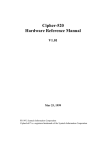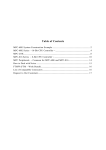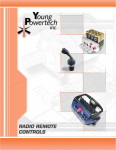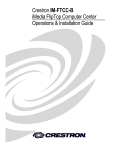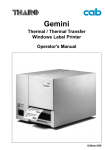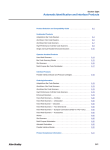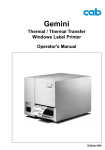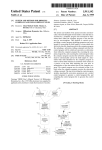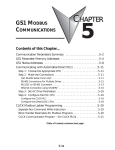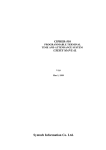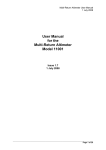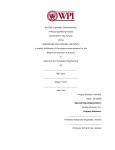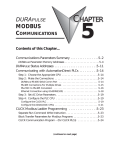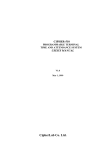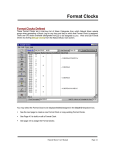Download 201 User Manual
Transcript
Cipher-201 Programmable Terminal User’s Guide CipherLab Co., Ltd. 1 1. Packing This packing includes: (1) This User's Guide (2) The Cipher-201 main unit (3) Optional LCD display and Calendar of Cipher-520 main unit(by order) (4) Power Adaptor (110VAC or 220VAC) (5) Default System Master Card (1234567890) 2 2. Components 2.1. Front View C1 DC Jack C2 Power Switch Speaker Ready LED LCD Good Read LED JP10 Reader 1 AUX232 Reader 2 External/Keyboard Note: The data memory can be a 32KB or 128KB SRAM. However, to accommodate different pin assignments, The SRAM type must be selected via the jumper (JP10) on the main board. 3 3. Installation 3.1. Power Source The Cipher-201 can be powered 8 to 20V from the DC jack and +5V from C1 or C2. In case this host power is not available or not adequate, a wall adaptor (in the range of 8 to 20V) can be fed via the DC-jack. 3.2. Reader Ports There are totally 2 reader ports provided, each can be either a Wand, Barcode slot reader, Barcode Scanner with Laser emulation or up to dual-track magnetic card reader. 3.3. External Keyboard Port An external AT-compatible keyboard can be attached for handy data entry. The connector and pin assignment conforms to PC/AT standards. 3.4. RS232 Connection The factory settings of the RS232 port are 9600 baud rate with 8 data bits, no parity, and 1 stop bit. And the Cipher-201s delivered from factory all have the line connection setting been set to multi-station on-line master. User can use Aux232 or C1 or C2 to connect computer and transfer data. 4 AUX232 RS232 C2 C1 RS-232 Configuration 3.5. RS485 Connection The RS485 ports are used to connect multiple Cipher-201s. Every Cipher-201 station is connected to the RS485 bus line in a daisy chain style. PC RS232 RS485 C2 RS485 Connect Others C1 RS-485 Connection between Cipher-201s 5 3.6. Digital I/O The Cipher-201 provides 2-digitsal inputs and 2-digitsal outputs for controlling and monitoring external devices. These inputs and outputs are photo-isolated and share the same DB-25 connector as the COM2 13. Digital Output 1 14. Digital Output 0 15. Digital Input 1 16. Digital Input 0 COM2 Port Connector and Digital Pin Assignment 3.7. Speaker A low power speaker is supported and the sound level is 4-level tunable. This speaker electrically behaves like a capacitor, which implies that current flows only when states are changed (charge/discharge capacitor) and very little power is consumed. However, a higher voltage, e.g. 10V is needed to drive it. 3.8. LED Indicator There are totally 2 LEDs on the panel for showing system status. ⋅ ⋅ READY, Red GOOD READ, Green 6 3.9. LCD Display A 2 x 20 LCD is used to display current system time, scanned card ID, system message and so on. This is an easy-to-read wide viewing angle LCD equipped with LED back light and can easily be read even in a dim environment. The viewing angle can be adjusted via a variable resistor as depicted in the Nomenclature. 7 4. Programming System Parameters The system parameters of Cipher-201 Terminal can be programmed manually or by RS232 commands. Manually programming the Cipher-201 terminal system is described in this section and programming the Cipher-201 via RS232 commands will be described under the section RS232 Command. 4.1. Manually programming Power on the Cipher-201 and scan the master card. Now Cipher-201 is waiting for entry of the password. However, if the password was set to none, this message will not be shown and this step is simply ignored. The system manager must key in the password now. If the password is correctly entered, Cipher-201 will be in the System Management mode where 2 major tasks can be done as follows, 1. Setup System Manager 1.Setup (1) Press the ENTER key and now the Cipher-201 is in the setup mode and is ready to accept system parameter modification. The Cipher-201 will show the name of parameter on the upper side of the display and the original setting value on the lower side. 2. Line Connection: =Master (2) Press ENTER key then you can change the setting value of this parameter. Use the ” ” and “ ” keys for selecting a new setting value or type in a new value via numeric keys. Then press ENTER key to conclude the new setting value. 1. Line Connection: -><Single> (3) After all the system parameter modification are completed, the F1 key must be pressed to update these modifications and 8 save the new settings into the program memory. System will restart with the new settings. If F2 key instead of F1 key is pressed, all modifications of the system parameters will be discarded and retain the original settings. (4) Followings are the system parameters, a. Station ID Setting b. Line Connection Setting c. Max. Station ID Setting d. Manager Card Setting e. Manager Password Setting f. LCD backlight Setting g. Master Card Setting h. Password Setting i. Buzzer Volume Setting j. Time Setting k. Timer Fine Tune Setting l. COM1 Setting m. COM3/AUX Setting n. Sybologies Setting o. Rdader1 Setting p. Reader2 Setting q. Time Stamp Setting r. ID Stamp Setting s. Source Stamp Setting 2. Self Test This mode provides a simple but yet efficient way for diagnostic. Press ENTER key for executing the following items test one by one, ⋅ ⋅ ⋅ ⋅ Flash test SRAM test Beeper test LCD test 9 ⋅ ⋅ ⋅ ⋅ ⋅ ⋅ ⋅ ⋅ ⋅ ⋅ ⋅ ⋅ ⋅ LED test DI & DO test COM1 test COM2 test COM3 test 485 test Wedge test ADC test Calendar test Reader test Keypad test AT Keyboard test Shutdown test 3. Init System This is used to set all system parameters to their default value and initialize the file systems. Care should be taken, as this will destroy all data stored in the memory. 4. Flash Clone This is used to copy the program in FLASH memory to another terminal. Usually it is used for diagnostic or software update. 5. Flash Download This is used to update program code stored in the flash memory. The code can be downloaded from a PC using the “MDL6” or as described in the previous section, from another machine. Also, the RS232 has been fixed to 38400,N,8. 10 4.2. Host Command The host computer can get access to terminals on the RS485 nets via COM1 of the master station. Basic characteristics of the Cipher-201 are listed below, 4.2.1 Command Format Each command is composed as <CC><ss><p..p>^,where, <CC> command code string <ss> 2 digits station ID depending on command code <p..p> parameters ^ delimiter carriage return, hex 0d 4.2.2 Command for master station The following commands are for master station only and thus NO station ID should specified. Command Code ONLINE Parameter Operation Echo null inquire on-line-status READ null read one record REMOVE null remove one record MAXID null or =ss inquire/set maximum station IDs to be polled null or inquire/set system time =YYMMD Dhhmmss aa,bb,..,cc lists of all station Ids that are currently on-lined including the master station itself d…d: if available OVER: if empty NEXT: done OVER: done and data file now empty ss: 2 digits maximum ID TIME YYMMDDhhmmss: system time after command execution. Once set, all stations on the net are 11 modified. Note: 1. The command REMOVE is effective only after current record has been read by Command READ, else the data file remains unchanged even NEXT is echoed. 2. When command TIME was issued, the master automatically issues a broadcasting Command to update all stations. ^ 4.2.3 delimiter carriage return, hex 0d Command for Individual station Individual station can be accessed via these commands and 2-digit station ID MUST be specified. Command Parameter Operation Echo inquire on-line status aa,bb,..,cc Code DCOUNT null stored in the data file TTUNE null or = offset inquire/fine tune calendar d..d: value of the tuning register offset = offset value from –128 to +127 MCARD null or = tm..m inquire/set master card tm..m: updated master card t: code type m..m: up to 20 characters card ID PWD null or = p..p inquire/set password p..p: updated password BL null or = d inquire/set backlight level d: updated backlight level d: 0 to 3 VOL null or = d inquire/set buzzer volume d: updated buzzer volume 12 d: 0 to 3 COM1 null or = b,p,d,h inquire/set COM1 setting b,p,d,h: updated settings b: baud rate from 0 to 7 p: parity from 0 to 3 d: data bits from 0 to 1 h: handshake from 0 to 3 COM3 null or = b,p,d,h inquire/set COM3 setting b,p,d,h: updated settings b,p,d,h: as above BCODE null or = p..p inquire/set symbologies p..p: updated setting p..p: 20 digits for each symbologies READER1 null or = s,t,r inquire/set reader1 s,t,r: updated setting s: scan mode from 0 to 7 t: time out from 0 to 225 r: redundancy from 0 to 3 READER2 null or = s,t,r inquire/set reader 2 s,t,r: updated setting s,t,r: as above TMSTP null or = d inquire/set time stamp d: update setting d: 1/0, enable/disable IDSTP null or = d inquire/set IDstamp d: update setting d: 1/0, enable/disable SRSTP null or = d inquire/set source stamp d: update setting d: 1/0, enable/disable 13 Cipher-201 Hardware Reference Manual V1.1 April 18, 2007 © 1995, CipherLab Co., Ltd. Cipher-201 Hardware Reference Manual 1. Table Of Contents 1. Table Of Contents .................................................................................................2 2. List Of Figures......................................................................................................3 3. Preface..................................................................................................................4 4. General Features ...................................................................................................5 5. Characteristics.......................................................................................................6 5.1. Electrical...................................................................................................6 5.2. Environmental...........................................................................................6 5.3. Physical ....................................................................................................6 6. Nomenclature........................................................................................................7 7.PCB .......................................................................................................................8 8. Power Circuit ........................................................................................................9 9. Reset ...................................................................................................................10 10. Program Memory (Flash) ..................................................................................11 11. Data Memory (SRAM)......................................................................................12 12. Calendar chip ....................................................................................................13 13. Memory and Calendar Backup Battery ..............................................................14 14. LCD..................................................................................................................15 15. Reader...............................................................................................................16 16. External Keyboard ............................................................................................17 17. Membrane Keypad ............................................................................................18 18. Interface C1 ......................................................................................................19 18.1. COM2...................................................................................................20 18.2. Wedge emulation ..................................................................................20 18.3. Power Pins ............................................................................................20 18.4. Loop Back Tester ..................................................................................20 19. Interface C2 ......................................................................................................21 19.1. COM1...................................................................................................22 19.2. Digital Input..........................................................................................22 19.3. Digital Output .......................................................................................22 19.4. Power Pins ............................................................................................22 19.5. Loop Back Tester ..................................................................................23 20. RS232 (COM3).................................................................................................24 21. LED ..................................................................................................................25 22. Speaker .............................................................................................................26 Table Of Contents Cipher-201 Hardware Reference Manual 2. List Of Figures Figure 1. Nomenclature.............................................................................................7 Figure 2. PCB ........................................................................................................8 Figure 5. SRAM type selector ..............................................................................12 Figure 6. SRAM connection.................................................................................12 Figure 7. LCD Connector.....................................................................................15 Figure 8. Reader 1 Connector...............................................................................16 Figure 9. External Keyboard Connector ...............................................................17 Figure 10. Keypad Connector...............................................................................18 Figure 11. C1 .......................................................................................................19 Figure 12. C2 .......................................................................................................21 Figure 13. COM3 .................................................................................................24 Preface Cipher-201 Hardware Reference Manual 3. Preface This manual provides in-depth hardware informations of the Cipher-201 programmable terminal and serves as a reference for hardware and maintenance engineers. Assumption has been made that readers of this manual have basic knowledge of electric and/or electronic theory. Numberings of all components, including connectors, passive and active components conforms to the PCB V3.01. However, CipherLab does not guarantee this conformity. The numberings and locations of components might be re-arranged. For confirmation, please refer to the PCB and its schematics. After all, this manual intends to describe the operation theory of the circuitry utilized. Preface Cipher-201 Hardware Reference Manual 4. General Features The Cipher-201 is equipped with the follows, • TLCS-900 16 bit CPU running at 9.8304 MHz • Program : 128 KB flash memory • Data memory : 32 or 128 KB SRAM • Optional Fine-tunable calendar chip • Memory & calendar chip backup 3.6V NiCd battery • 2 reader ports for barcode Wand, Laser-emulation scanners or up to dual-track magnetic card reader. • optional 2 X 20 characters dot-matrix LCD display with adjustable back-light and viewing angle • optional 4 X 4 membrane keypad • 2 digital input ports • 2 digital output ports • external keyboard port (AT keyboard) or keyboard emulation • 3 serial communication ports, depending on ports, can be configured as RS232, CMOS RS232 or RS485 General Features -5- Cipher-201 Hardware Reference Manual 5. Characteristics Basic characteristics of the Cipher-201 are listed below, 5.1. Electrical Main Power Supply Voltage : • 8 to 20 V DC from DC-jack • +5V from C1 or C2 Power consumption : 0.5W maximum without LCD nor external devices attached • • 5.2. Environmental • • • • • Humidity (operating) : non-condensed 20% to 90% Humidity (storage) : non-condensed 10% to 95% Temperature (operating) : 0 to 50 Temperature (storage) : -20 to 70 EMC regulation : FCC class A and CE approved 5.3. Physical • • • • Dimensions : 179 * 116 * 32 mm (without LCD) Weight : 300 gram maximum (without LCD) Material : ABS Color : Gray Characteristics -6- Cipher-201 Hardware Reference Manual 6. Nomenclature The overall out-looking and connector locations are depicted below, C1 DC JACK C2 POWER SWITCH SPEAKER READY LED GOOD READ LED AUX 232 READER 1 READER 2 EXTERNAL KEYBOARD Figure 1. Nomenclature Nomenclature -7- Cipher-201 Hardware Reference Manual 7. PCB The PCB and locations of major components are shown below, C2 C1 DC-Jack Power Switch LCD Connector flash Speaker SRAM JP10 Keypad Battery Reader 1 Reader 2 External Keyboard Figure 2. PCB Aux RS232 PCB -8- Cipher-201 Hardware Reference Manual 8. Power Circuit The 201 can be powered in two ways, • 8 to 20 V from the DC jack • +5V from C1 or C2 Later is used mostly for keyboard emulation decoders where the power can be drawn from the host computer. In case this host power is not available or not adequate, an wall adapter (in the range of 8 to 20V) can be fed via the DC-jack. As long as this external power is asserted, the +5V from C1 or C2 is disconnected via an internal FET switch. A simple buck-type switching regulator (LM2575) is followed to generate the required system power, +5V. This regulator is capable of providing up to 1 Amp currents and provides a reasonable typical efficiency around 70% to 80%. Low-ESR (equivalent series resistance) type electrolytic capacitors are used both at input and output sides to reduce ripples. - + Figure 3. Main Power Connector The power is controlled via a dual pole dual throw (DPDT) type switch and a resistor is used to discharge the output capacitor when switch was turned off (namely, to the OFF side). As the 201 itself consumes very little power (typical 50mA with LCD back-light off, no external devices attached), this ensures a sharp power up and down sequence. DC/DC Converter DC-jack DPDT Power Switch +5V Figure 4. Power Circuit +5V FET Switch Power Circuit -9- Cipher-201 Hardware Reference Manual 9. Reset The system reset signal is generated by a voltage detector chip RICO RE5V or compatible chips. It outputs an active low reset signal when the system power drops below a pre-determined voltage level (Vdet-). The reset signal then changes to high when the power is higher than another pre-determined voltage level (Vdet+). The Vdet+ is about 200 mV higher than Vdet-, this phenomenon known as hysteresis, prevents noise to false-trigger the reset circuitry. The TLCS-900 is guaranteed to work within 5V 10% and the Vdet- is set to 4.6V. This reset signal does not only ensure the proper operation of the CPU but is also used to reset the UART chip (NS82C50) and disables SRAM access (connecting to SRAM CE2) during power-up and power-down. The later is very important as the SRAM contents might be changed by unwanted spikes during supply voltage change. Reset - 10 - Cipher-201 Hardware Reference Manual 10. Program Memory (Flash) 128 Kbytes flash memory (U2) is used to store the program code and is guaranteed to last at least 100,000 erase/program cycles. 2 kinds of flash chips can be used, the AMD 29F010 and 28F010 from Intel, MX and so on, and the access time must be 150 ns or faster. The former is a pure +5V device whereas the later requires a +12V for erasing/programming. U3 and accompanying passive components are used to generate this +12V. The U3 can be a Maxim MAX660 or Linear Technology LT1262, which two are total-compatible. Instead of inductor type switching DC/DC converter, these chips utilize a capacitor switching type circuitry and features smaller PCB space, lower ripple and lower EMI emission. The +12V generation is controlled by a CPU output pin and types of flash memory utilized is automatically identified by software (refer to software manual, routine download() ). That is, if 29F010 is used, this circuit is not enabled. During normal read, this DC/DC converter is disabled and the voltage stays at 0V. Program Memory (Flash) - 11 - Cipher-201 Hardware Reference Manual 11. Data Memory (SRAM) The data memory can be a 32KB or 128KB SRAM. However, to accommodate different pin assignments, the SRAM type must be selected via the jumper, JP10 as follows, 256 K Bit 1 M Bit JP 10 Figure 5. SRAM type selector Also, the SRAM should be plugged as follows, 1 M Bit PIN 1 256 K Bit U1 PIN 3 U1 PIN 1 Figure 6. SRAM type connection The SRAM used must be LL type to reduce battery power consumption and with access time 150 ns or faster. These SRAMs are backup by a NiCd battery and will be described in detail later. Data Memory (SRAM) - 12 - Cipher-201 Hardware Reference Manual 12. Calendar chip A battery backup calendar chip is used to retain the system time even when power is off. The chip utilized is a V3022 from EM micro-electronic Marin SA. It features the following outstanding features, • Very low power consumption When powered from the battery (3.6V), the current is typically 0.9 µA and maximally 1.5 µA. • Wide operation voltage range This chip works down to 2.0 V. • On-chip high precision oscillator This is a must for accurate time keeping as it is factory trimmed and external oscillators tend to be effected by outside electro-magnetic noise, temperature and so on for the long leads and traces. • Timer Adjustment It can also be fine tuned to compensate for a fast or slow clock. This is an outstanding feature for those applications which need punctual system time such as a time/clock application. The tuning of the calendar chip is done by modifying the value of the trimming register of the calendar chip. • Trimming Register The frequency of the calendar chip can be tuned in units of ppm via a digital trimming register. The trimming range is from 0 to 255 ppm. The bigger the value of the trimming register the slower the calendar chip runs. For instance, if the calendar chip is 1 second slow in one day then the value of the trimming register should decrease 12 to correctly adjust the calendar chip. During system initialization, this register is set to 186. 1 sec/ 1 day = 1000000 / (24 hours X 60 min X 60 sec) = 11.57 ppm ~= 12 ppm • Write-protected Unless changing calendar time is needed, it is write-protected and won't be accidentally changed. • Cold start detection A cold start bit is set if power loss encountered or first power-on. The software can then recognize this bit and initialize the calendar chip. Calendar chip - 13 - Cipher-201 Hardware Reference Manual 13. Memory and Calendar Backup Battery A 3.6V rechargeable NiCd battery is used to backup the SRAM and keeps the calendar chip running even when system power is off. Its capacity is 60 mAh and is trickle charged with a typical 1.2 mA current. After fully charged, it is able to sustain for more than 15 months. For example, • SRAM (LL-type, SONY CXK581000), current consumed is 0.7 µA (typical) and 4.0 µA (max., 0 to 40 ) • V3022 : 0.9 µA (typical), 1.5 µA (max.) Time (typical) = 60 mAh / (0.7 + 0.9) = 37500 hrs = 1563 days > 52 months Time (worst) = 60 mAh / (4.0 + 1.5) = 10909 hrs = 455 days > 15 months Although behaves in similar ways, unlike system power, switching between +5V and battery is done by 2 transistors and some passive components. This circuit features a very low leakage (base to collector leakage current of the PNP transistor Q1) back to the +5V and a low voltage drop (saturated Vce, ~0.2V). This low drop is necessary for most CMOS chips. If you are interested in this issue, pick up some CMOS chip data sheets. When system power is supplied, the supply voltage for these chips (SRAM & calendar) is +5V - Vdrop. Whereas signals are directly from/to CPU and other chips, which are supplied with +5V. However, for SRAM (a CMOS chip), the upper limit of input signal is Vdd + 0.5V. If using diodes such as 1N4148 for switching, the voltage drop is also 0.6V which is too large and will damage these chips. Memory and Calendar Backup Battery - 14 - Cipher-201 Hardware Reference Manual 14. LCD An optional 20 X 2 LCD display can be equipped as follows, 7 P J 2 6 1 1 5 1 X 0 2 2 X X 0 ,4 4 Figure 7. LCD Connector 1. 2. 3. 4. 5. 6. 7. 8. Ground Vcc, +5V view angle adjust A0 A1 CS D0 D1 9. 10. 11. 12. 13. 14. 15. 16. D2 D3 D4 D5 D6 D7 Back-light Anode Back-light Cathode Note that although utilizing the same LCD display as the 510, these 2 displays are not interchangeable. Signals on the connector are mirrored, this reversal of the power pins will destroy the display. The LCD is equipped with LED back-light and can be 4 levels tuned. 2 high current NPN transistors (500 mA maximum), Q8 and Q9 are used to drive the back-light and Q8 provides twice current Q9 does. Controlling Q8 & Q9 yields current ratios from 0, 1, 2 to 3. Iback-light = (Vcc - Vce (saturated) - Vf ) / R Where, Vcc = supply voltage, +5V Vce (saturated) = transistor collector to emitter saturation voltage Vf = LED forward voltage R = resistor The typical back-light current is then (5 - 0.2 - 3.8) / 20 = 50 mA. That is, from 0 to 150 mA on a 50 mA basis. As this is an STN-type LCD and the viewing angle is quite large, view angle adjustment is unnecessary. LCD - 15 - Cipher-201 Hardware Reference Manual 15. Reader There are totally 2 reader ports provided, each can be either a Wand, Barcode slot reader, Barcode Scanner with Laser emulation or up to dual-track magnetic card reader. They are equivalent in both hardware and software. Their connectors and pinassignments are listed below. Beware that in order to decode barcode and magnetic card at the same time, some signals share the same pin. However, the software is able to tell types of the readers attached. DB-9 Male 1 2 6 3 7 4 8 5 9 Front Veiw Figure 8. Reader Connector JP4 & 6 1 2 3 4 5 6 7 8 9 Reader Barcode Start Of Scan Data Good Read Not Used Switch Power Enable Ground Not used Vcc, +5V Magnetic Not used Clock 1 Not used Data 1 Clock 2 Not used Ground Data 2 Vcc, +5V - 16 - Cipher-201 Hardware Reference Manual 16. External Keyboard An external AT-compatible keyboard can be attached for handy data entry. The connector and pin assignment conforms to PC/AT standards. DIN 5F 3 1 5 2 4 1. 2. 3. 4. 5. clock data No connection ground +5V Front View Figure 9. External Keyboard Connector However, these signals are also used to simulate a keyboard when configured as a wedge-type decoders. In that case, this connector should be left unconnected and the CipherLab special wedge cable for that particular wedge emulation should be plugged to C1. Then the original keyboard used by that host computer can be then attached to the special wedge cable. External Keyboard - 17 - Cipher-201 Hardware Reference Manual 17. Membrane Keypad A standard 16-key membrane keypad is provided for data entry. JP 2 8 1 Figure 10. 1. 2. 3. 4. Membrane Keypad In 1 In 2 In 3 In 4 Keypad Connector 5. 6. 7. 8. Out 1 Out 2 Out 3 Out 4 - 18 - Cipher-201 Hardware Reference Manual 18. Interface C1 This is a 25 pin D-type female connector as depicted below, 13 1 25 14 Figure 11. 1. 2. 3. 4. 5. 6. 7. 8. 9. Ground TxD 232, transmit data RS232 level RxD 232, receive data RS232 level RTS 232, RTS, RS232 level CTS 232, CTS RS232 level short to C2 pin 6 Ground short to C2 pin 8 TxD CMOS, transmit data CMOS level 10. RxD COMS, receive data, CMOS level 11. RTS CMOS, RTS, CMOS level 12. CTS CMOS, CTS CMOS level C1 13. keyboard-emulation signal 1 14. keyboard-emulation signal 2 15. keyboard-emulation signal 3 16. keyboard-emulation signal 4 17. keyboard-emulation signal 5 18. keyboard-emulation signal 6 19. No connection 20. short to C2 pin 20 21. RS485 + 22. RS485 23. +5V power input 24. +12V power output, directly from DC-jack 25. +5V power output It contains the follows, • Serial communication COM2, one and only one of the follows can be used, • RS232 • CMOS-level RS232 • RS485 • Wedge emulation • External power input • Power pins Interface C2 - 19 - Cipher-201 Hardware Reference Manual 18.1. COM2 This communication port can be used as RS485, RS232 or CMOS-level RS232. However as they share the same UART, only one of them can be used at a time. On the software part, the RS232 and CMOS-level RS232 functions the same. For details of the RS-485 usage, please refer to Cipher-510 hardware reference manual. 18.2. Wedge emulation Up to 6 pins are reserved for keyboard emulation use. When configured as a wedgeemulation decoders, please attach the CipherLab specified cable for that particular machine. 18.3. Power Pins As stated earlier, the 201 can be powered from external +5V through this connector or an unregulated +8V to +20V through the DC-jack. • Pin 23, +5V power input can be used to draw power from host computer, usually when configured as a decoder. However, as stated earlier, this power source is automatically disconnected by an FET switch if an external power is fed through the DC-jack. • Pin 24, +12V output : this is the power switch gated power from the DC-jack and can be used to power external devices. However, in doing so, the overall power consumption and adapter power rating must be examined. • Pin 25, +5V output : this is the power switch gated +5V regulated by the on-board DC-DC converter and can be used to power external devices. However, the onboard regulator is able to supply up to 1 Amp current. In doing so, the overall power consumption must be examined. 18.4. Loop Back Tester 2 Loop back testers can be used accompanying self-test codes for diagnostics. • • For RS232 & wedge emulation signals, 2 3 13 15 4 5 14 16 47K 47K 25 25 For CMOS RS232 & wedge emulation signals, Interface C1 9 10 13 15 11 12 14 16 47K 47K 25 25 - 20 - Cipher-201 Hardware Reference Manual 19. Interface C2 This is a 25 pin D-type male connector as depicted below, 1 13 C2 14 25 Figure 12. 1. 2. 3. 4. 5. 6. 7. 8. 9. Ground RxD 232, receive data RS232 level TxD 232, transmit data RS232 level CTS 232, CTS RS232 level RTS 232, RTS, RS232 level short to C2 pin 6 Ground short to C2 pin 8 RxD COMS, receive data, CMOS level 10. TxD CMOS, transmit data CMOS level 11. CTS CMOS, CTS CMOS level 12. RTS CMOS, RTS, CMOS level C2 13. Digital Output 1 14. Digital Output 0 15. Digital Input 1 16. Digital Input 0 17. No connection 18. No connection 19. No connection 20. short to C2 pin 20 21. RS485 + 22. RS485 23. +5V power input 24. +12V power output, directly from DC-jack 25. +5V power output It contains the follows, • Serial communication COM1, one and only one of the follows can be used, • RS232 • CMOS-level RS232 • Digital Input/output • External power input • Power pins Interface C2 - 21 - Cipher-201 Hardware Reference Manual 19.1. COM1 This communication port can be used as RS232 or CMOS-level RS232. However as they share the same UART, only one of them can be used at a time. On the software part, the RS232 and CMOS-level RS232 functions the same. 19.2. Digital Input 2 digital inputs are equipped. However, unlike 510, these 2 signals are not photoisolated and are directly connected to CPU Input pins, thus care must be taken in handling these pins. Also, on the software side, the read value is inverted. That is, if this pin is at high (2.2 ~ 5.3 V), the get_din() will return 0. Whereas 1 is returned if it is at low (-0.3 ~ 1.5V). When floated, 2 on-board pull-up resistors keep these signals at high. 19.3. Digital Output 2 digital outputs are equipped. However, unlike 510, these 2 signals are not photoisolated and are directly connected to CPU Output pins, thus care must be taken in handling these pins. Also, on the software side, if it is set ON by set_do(), the pin goes to low. Whereas it goes to high when set OFF. The output drive capability is limited as below, • Output low voltage : maximally 0.45V if sinking 1.6 mA • Output high voltage : minimally 2.4V if sourcing 400 µA and minimally 3.75V if sourcing 100 µA Buffering is strongly recommended. 19.4. Power Pins As stated earlier, the 201 can be powered from external +5V through this connector or an unregulated +8V to +20V through the DC-jack. • Pin 23, +5V power input can be used to draw power from host computer, usually when configured as a decoder. However, as stated earlier, this power source is automatically disconnected by an FET switch if an external power is fed through the DC-jack. • Pin 24, +12V output : this is the power switch gated power from the DC-jack and can be used to power external devices. However, in doing so, the overall power consumption and adapter power rating must be examined. • Pin 25, +5V output : this is the power switch gated +5V regulated by the on-board DC-DC converter and can be used to power external devices. However, the onboard regulator is able to supply up to 1 Amp current. In doing so, the overall power consumption must be examined. Interface C2 - 22 - Cipher-201 Hardware Reference Manual 19.5. Loop Back Tester 2 Loop back testers can be used accompanying self-test codes for diagnostics. • • For RS232 & wedge emulation signals, 2 3 13 15 4 5 14 16 47K 47K 25 25 For CMOS RS232 & wedge emulation signals, 9 10 13 15 11 12 14 16 47K 47K 25 25 Connection of this tester is identical to that of the C1 except connector polarity. Thus a one to one gender (male to female changer or female to male changer) can be used to swap between C1 and C2. Interface C2 - 23 - Cipher-201 Hardware Reference Manual 20. RS232 (COM3) An auxiliary RS232 is equipped in the front panel as below, 1. 2. 3. 4. 5. 6. 7. 8. 9. DB-9 Male 1 2 6 3 7 4 8 5 9 Front Veiw Figure 13. RS232 (COM3) No connection Receive data, RS232 level Transmit data, RS232 level No connection Ground No connection RTS, RS232 level CTS, RS232 level +5V COM3 - 24 - Cipher-201 Hardware Reference Manual 21. LED There are totally 2 LEDs on the panel for showing system status. • READY, Red • GOOD READ, Green The GOOD READ LED is activated if one or both of the reader good read LED is activated. That is, these two reader good read signal is Ored to drive this on-board LED. LED - 25 - Cipher-201 Hardware Reference Manual 22. Speaker A low power speaker is supported and the sound level is 4-level tunable. This speaker electrically behaves like a capacitor, which implies that current flows only when states are changed (charge/discharge capacitor) and very little power is consumed. However, a higher voltage, e.g. 10V is needed to drive it. To do this, the speaker is driven by a pair of complementary CMOS-level 5V signals to produce a virtually 10V peak to peak signals across the speaker. This peak to peak voltage level is altered to control the sound level. Up to 4 sound levels can be set and the corresponding peak to peak voltages are 2.5 V, 5 V, 7.5 V and 10 V. The working frequency ranges from 1KHz to 6KHz and have a peak around 4 KHz. Speaker - 26 -








































